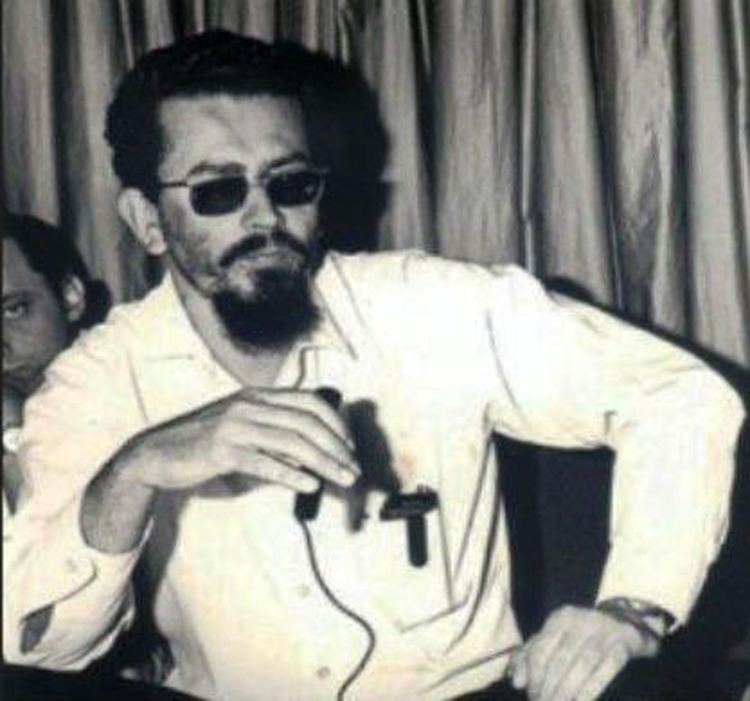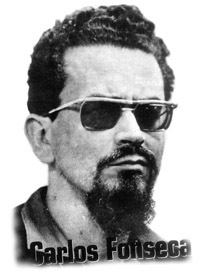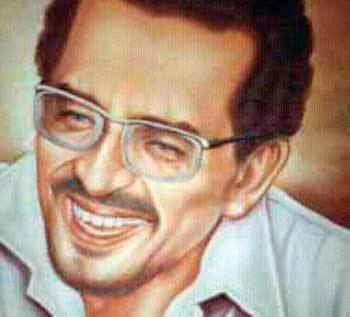Name Carlos Fonseca | Died November 7, 1976 | |
 | ||
Parent(s) Fausto Amador AlemanAugustina Fonseca Ubeda Books Sandino Without Frontiers: Selected Writings of Augusto Cesar Sandino on Internationalism, Pan-Americanism, and Social Questions Similar People Augusto Cesar Sandino, Tomas Borge, Daniel Ortega, Sergio Ramirez, Moises Omar Halleslev | ||
Comandante carlos fonseca
Carlos Fonseca Amador (June 23, 1936 – November 8, 1976) was a Nicaraguan teacher and librarian who founded the Sandinista National Liberation Front (FSLN). Fonseca was later killed in the mountains of Nicaragua, three years before the FSLN took power.
Contents
- Comandante carlos fonseca
- Comandante carlos fonseca homenaje 2012
- Early years
- Early Political Activity
- Taking Up Arms
- Sandinista
- Popular culture
- References

Comandante carlos fonseca homenaje 2012
Early years

Born in Matagalpa, a town in northwestern Nicaragua, Fonseca was the son of Augustina Fonseca Úbeda, "an unmarried twenty-six-year-old washerwoman from the countryside". His father, Fausto Amador Alemán, a member of the prominent coffee-growing Amador family, did not acknowledge Fonseca until his elementary school years. Fonseca's father was part of a wealthy family, while his mother was a peasant. His father helped him later on to go to school and educate himself, but he always admired his mother more, because of her work ethic and strength. Because of this, Fonseca would repeatedly use her last name first, and was consequently known as Carlos Fonseca Amador.

In 1950, Fonseca entered secondary school and slowly became involved with political groups. In the early 1950s, he attended meetings for a Conservative Party youth group and joined the Unión Nacional de Acción Popular (UNAP, National Union of Popular Action). Fonseca became increasingly interested in Marxism and joined the Partido Socialista Nicaragüense (PSN, Nicaraguan Socialist Party). He left the UNAP in 1953 or 1954, complaining they were too "bourgeoisified" on social issues (the poor, the student movement, etc.) and that it "did not take on the Somoza government. In 1954, he and several school friends founded and began to publish a "cultural journal" called Segovia."
Early Political Activity

Fonseca was arrested by the Guardia Nacional and held for nearly two months. According to Zimmermann, at this point Fonseca remained "committed to nonviolent methods and believed the PSN provided the leadership Nicaragua needed".
In 1957, Fonseca traveled to the Soviet Union as a PSN delegate to the 6th World Festival of Youth and Students organized by the World Federation of Democratic Youth. Fonseca later wrote a book chronicling his visit to the USSR entitled Un Nicaragüense en Moscú ("A Nicaraguan in Moscow"). The book featured uncritical praise of the accomplishments of the Soviet government, including its "free press, complete freedom of religion and the efficiency of its worker-run industries". Not listed in the book, he traveled to San Francisco, USA, to stay with his relatives (Albert Amador, Sr. & Maria Amador) and to attend community college.
Taking Up Arms
Fidel Castro and the 26th of July Movement took power in Cuba on January 1, 1959. The Cuban Revolution was a major event all over Latin America and sparked both great concern and a sense of possibility in Nicaragua. The Cuban Revolution was a central event in Fonseca's political evolution as it "convinced [him] that revolution was possible and that a new organization was needed to lead it"[pp. 56–57, Matilde Zimmermann, Sandinista: Fonseca and the Nicaraguan Revolution (Durham, NC: Duke University Press, 2000)]. Just as the Cuban revolution "had been organized outside the framework of the Cuban Communist Party", a Nicaraguan revolutionary movement could be created outside of the PSN and other pre-existing groups.
The rebel victory in Cuba was mirrored by an increase in armed anti-Somoza actions in Nicaragua. Fonseca took part in one such uprising in 1959. In February of that year, Fonseca, as well as many other more prominent Nicaraguan radicals, traveled to Cuba.
In mid-1959, Fonseca joined a Nicaraguan guerrilla brigade which had a training camp in southern Honduras. On June 24, 1959, the brigade was ambushed by Honduran and Nicaraguan troops in Honduras, ending in the death of several rebels and the wounding and capturing of many others, including Fonseca.
This incident marks the end of Fonseca's relationship with the PSN. Whereas Fonseca's revolutionary zeal increased in the aftermath of the ambush, the PSN became convinced that a revolution in Nicaragua was "impossible". Labelling Fonseca and other Nicaraguans who fought in the brigade as too "guerrilla-ist," the PSN expelled Fonseca and the others.
It is a bit unclear how (it has been rumored that his father Fausto Amador pulled strings to free him), but Fonseca managed to leave the military hospital in Honduras where he was taken after the June 24th ambush and went to Cuba. It is at this point that Fonseca "began a serious study of Sandino". Fonseca also began to host political meetings in a small apartment in the Miramar section of Havana. The meetings were frequented by people who would later become part of the FSLN.
Sandinista
Between 1959 and 1963, Fonseca and those who would become the earliest members of the FSLN "experimented with a variety of different organizational forms" in the hopes of forming a true revolutionary organization. Having formed several short-lived groups, the FSLN came to be in 1963. Originally, Fonseca hoped to duplicate the Cuban revolution in Nicaragua, drawing up battle plans based on the Cuban experience.
In mid-1963, a guerrilla cadre entered the Rios Coco y Bocay area of Nicaragua. Poorly prepared and having done little advance work in the area, several guerrillas were killed by the Guardia Nacional, while others were able to escape across the Honduran border. This incident would highlight the error of having an "excessive emphasis on military actions without corresponding political work".
In June 1964, Fonseca and Víctor Tirado were arrested in Managua. The two (along with four others) were accused of plotting to assassinate Anastasio Somoza Debayle. Rather than present a defense during his trial, Fonseca leveled charges against Somoza which were later detailed in his manuscript, From Prison, I Accuse the Dictatorship.
Between 1964 and 1966, the FSLN "concentrated on educational work and community organizing", creating indoctrination classes and campaigning to bring resources to working-class neighborhoods in Managua. While Fonseca continued to hold the top leadership position in the FSLN, he was out of the country for much of the mid-1960s period, having fled to Mexico and then Costa Rica.
By mid-1966, plans for a second FSLN guerrilla operation in the Pancasan region (near Matagalpa) were underway. The operation began in May 1967 with about forty guerrillas. This time, the guerrillas were better trained and armed, and more interestingly, had women among their ranks. Fonseca, along with a few other FSLN leaders were "committed to the idea of including women", however, some of the other fighters were not comfortable fighting alongside women. Like the earlier guerrilla incursion, the Pancasan operation ended with many of the FSLN guerrillas being wiped out by the Guardia Nacional. However, Fonseca, and the others that survived, considered the operation a political victory "because it showed the whole country that the FSLN still existed"./. It was during this time, in late November of 1967 that Fonseca was hidden, for a week and by members of the FSLN, at the least likely of places, the Managua downtown home of the First Lady of the Liberal Party, Woman of the Americas and of Nicaragua as per the Unión de Mujeres Americanas Dame Angelica Balladares de Arguello,(b. Dec. 19,1872- d.September 8, 1973), then 95 years old.
In his book The World Was Going Our Way, Vasily Mitrokhin relates how, as part of the KGB's Aleksandr Shelepin’s strategy of using national liberation movements to advance the Soviet Union's foreign policy in the Third World, Shelepin organized funding and training in Moscow for twelve individuals that Fonseca handpicked, and the twelve were the core of the new Sandinista organization. However, UCLA historian J. Arch Getty, whose specialty is Russia, writing in the American Historical Review, raised questions about the trustworthiness and verifiability of Mitrokhin's material about the Soviet Union, doubting whether this "self-described loner with increasingly anti-Soviet views" would have had the opportunity to "transcribe thousands of documents, smuggle them out of KGB premises", etc. Former Indian counter-terrorism chief Bahukutumbi Raman also questions both the validity of the material and the conclusions drawn from them.
Popular culture
In the mid 1980s, musician Paul Kantner traveled to Nicaragua out of concern for the Sandinista situation. While in the country, he was given a song called "Comandante Carlos Fonseca", written by composer Carlos Mejía Godoy and revolutionary Tomás Borge. After reforming Jefferson Starship in the 1990s, he added the song to his repertoire, eventually recording the song for the 2008 album Jefferson's Tree of Liberty.
